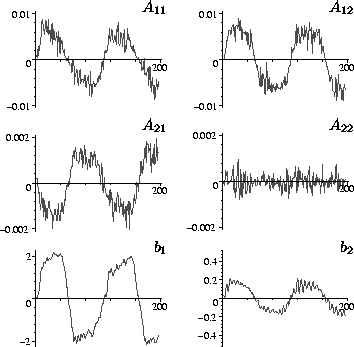
The estimator was also tested on a real image sequence of an upturned basket being rotated on an office chair in front of a stationary video camera. Four frames from the sequence are shown in Fig.\ 8. Twenty regions were selected by hand and then tracked over the sequence as in the previous experiment. The computed affine flow parameters for one of the regions are shown in Fig.\ 7. Fig. 8 shows the initial structure state (top left) with normals pointing towards the camera and equal depths, and the evolved structure for frames further on in the sequence. In this experiment the filter was iterated three times (forwards, backwards and forwards through the sequence) to remove the initial transient estimates. Again, the filter clearly captures the surface structure. As shown in Fig. 9, the motion was predominantly cyclic translation in X and rotations about the Y and Z axes. Note also the convergence of the inverse focal length to a steady value of around 0.2. The image sequence is also available as an mpeg movie.
Figure 7: Affine flow parameters computed for one of the regions in the basket sequence
Figure 8: Frames and estimated platelets for the basket sequence.
Figure 9: Motion and inverse
focal length estimates obtained for the basket sequence.